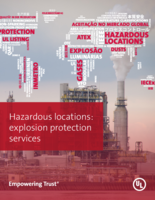
Hazardous Locations Explosion Protection Services
Gain a better understanding of IECEx certification and area classification, including HazLoc markings with UL Solutions, an approved test laboratory and certification body.

The IECEx System is an international system for the safety of equipment installed in a potentially explosive atmosphere. It is similar to the IECEE CB scheme. It is based on the IEC 60079 and IEC 80079 series of standards facilitated by the TC31 technical committee. UL Solutions participates in and leads many of the TC31 technical committees leading the charge of standards evolution.
UL Solutions is one of the top issuers of global IECEx and ATEX certifications. This supports acceptance of your UL Solutions-issued certificates, test reports and quality audits for local country marks around the globe. The UL Solutions brand is highly recognized and accepted by certifiers, installers and regulators in local, regional or international markets. Leverage our global brand acceptance and trust to add value to your innovations.
UL Solutions is an approved test laboratory and certification body within the IECEx Certified Equipment, Certified Service Facilities, Personnel Competency and Recognized Training Provider programs.
Certification process services include:
UL Solutions availability to provide the services may be limited by export controls, sanctions, or other applicable law.
IEC = International Electrotechnical Commission
Ex = Explosive atmospheres
IEC + Ex = IECEx
IECEx System = IEC System for Certification to Standards relating to Equipment for use in Explosive Atmospheres
IECEx certification provides assurance that all safety requirements in the IEC standards are met and that both explosive atmosphere areas and the personnel working within them are as safe as possible.
IECEx
ATEX

IECEx Hazardous areas are divided into zones, groups, protection types and EPLs.
Mines susceptible to firedamp
Thanks for your interest in UL's products and services. Let's collect some information so we can connect you with the right person.